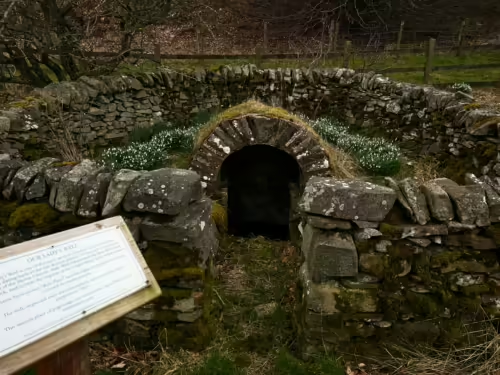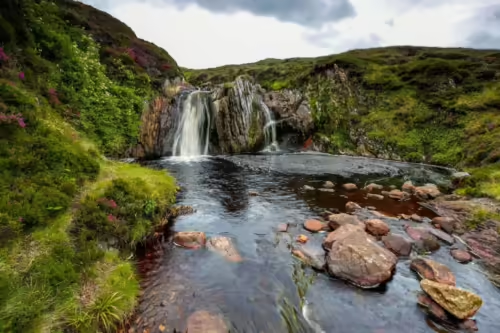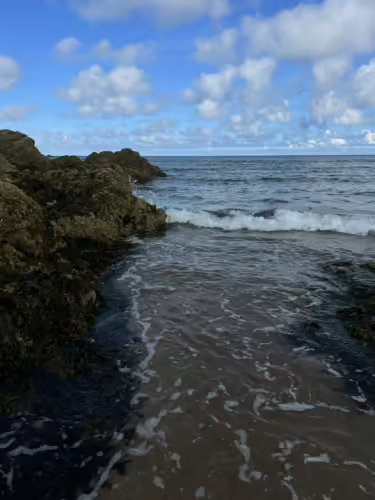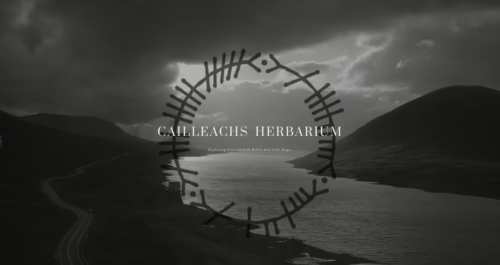In Scottish cosmology, sacred waters such as our sea and rivers are more than elements; they are animated by their own spirits and present to us gateways to profound wisdom, spiritual insight, and personal power. Water is life and wise rulers go out their way to protect it. This connection is pivotal in folk belief and folk magic and reflects deeper poetic metaphorical narratives about transformation and our ability to change. Seas and Rivers are never the same shape twice, constantly shifting. By examining Scottish and Gaelic tales and traditions, we see how water acts as a catalyst for growth, revelation, self-discovery, poetry and insight.
Water as Wisdom and Personal Revelation
In Scottish tripartite cosmology, water sometimes represents the chthonic, a gateway to another world. The sea is not merely a symbol of healing and communication but a conduit for eolas – knowledge and imbas – inspiration. These concepts link water to personal transformation; in ancient societies, those who sought and accessed sacred wisdom often gained the ability to effect profound change within themselves and others. The act of seeking out such sources was itself an expression of inner courage and the desire for growth.
An example of the urge for knowledge is the salmon of wisdom, a recurring motif in Celtic mythology who swims these sacred waters. The salmon is a vessel of profound knowledge and links Scottish and Irish tales. In the story of Fintan, the oldest and wisest man who underwent multiple transformations, including a phase as a salmon, we find the essence of this symbolism. During his time as a salmon, Fintan roamed the world’s great rivers, gathering unparalleled wisdom. His journey concluded at Assaroe, where he was overwhelmed by its mighty waterfall. Another creature is mentioned a hawk and the Hawk of Achill represents this story.
Fintan and the Hawk had a fateful meeting during his salmon-phase:
20. A hawk came out of cold Achill,
Above the river-mouth of Assaroe;
I will not hide the fact, mysterious as it was,
He carried away with him one of my eyes.21. From that night ‘The Blind One of Assaroe’
I was named; it was a cruel act,
From that out I am without my eye:
Small wonder for me to be aged.
….
26. For five hundred years I have been blind
As a long-sided heavy salmon,
On lochs, on diverse rivers,
On every rich clear-flowing sea.27. For fifty years I was an eagle,
The Hawk of Achil
Few were the birds that would fill my place;
A hundred years happily
I was a stately blue-eyed falcon.
There’s a deep meaning in this keeping of time, with much to think about. The mention of the removal of one of his eyes link us back to the story of the start of the world as spoken of by the Cailleach – if you are unfamiliar with it I have explored it previously.
Stories are to be understood by the listener, though throughout this piece I offer interpretations of my own. The waterfall found at Assaroe isn’t solely a geographical location but a potent symbol of the internal power needed to face the climax of one’s personal journey, the end of the salmons journey to spawn perhaps to poetical ears becomes a moment of deep confrontation with self, where the roar of cascading waters echoes the tumult of inner revelation.
Similar tales exist at Ballyshannon, where the salmon Goll Essa Ruaid, known as the ‘one-eyed of the red waterfall’, meaning Asseroe (Eas Ruaid in Irish) and this is the Salmon alluded to in our Cailleach story embodying hidden knowledge. The idea of hidden knowledge found in natures creatures like salmon and white snakes holds a deep mystery, linking humans to our relationship with the land and the strength of the otherworld through centuries. These motifs are kept alive in the tales of hero/sorcerer called Finn Mchuill. In one version of the Finn Mchuill stories, he speared the salmon of wisdom himself at these very falls. The cooking consuming of the salmon/snakes/magic potions is a motif in our tales which leads to the gift of Imbas-forosnai and wisdom. A gift from another world into his one through the medium of water is really an important motif to grasp in understanding Scottish folk magic.
This salmon is alluded to in Scottish folklore as well, appearing carved into Pictish stones, a testament to the enduring importance of water as a holder of transformative knowledge. These stories remind us such wisdom is not freely given but earned through persistent seeking, reflection, and overcoming trials. The glistening scales of the salmon, shimmering under dappled light, evoke the brilliance of insights gained through deep introspection, its lithe body representing the hardship it is to grasp this learning coming from another place.

The Well of Segais: The Source of Inner Strength
Central to understanding sacred waters role in personal transformation is the Well of Segais, considered the source of both the Boyne and Shannon rivers and a fountain of otherworldly knowledge.
We are given a number of descriptions of this otherworldly well.
“Then he sees… a shining fountain, with five streams flowing out of it, and the hosts in turn a drinking its water. Nine hazels of Buan grow over the well. The purple hazels drop their nuts into the fountain, and the five salmon which are in the fountain sever them and send their husks floating down the streams. Now the sound of the falling of those streams is more melodious than any music…
The fountain which thou sawest, with the five streams out of it, is the Fountain of Knowledge, and the streams are the five senses through the which knowledge is obtained. And no one will have knowledge who drinketh not a draught out of the fountain itself and out of the streams. The folk of many arts are those who drink of them both”.
From “Cormac’s Adventure in the Land of Promise,” translated by Whitley Stokes
Connla’s well, loud was its sound,
was beneath the blue-skirted ocean:
six streams, unequal in fame,
rise from it, the seventh was Sinann.
The nine hazels of Crimall the sage
drop their fruits yonder under the well:
they stand by the power of magic spells
under a darksome mist of wizardry.
Together grow, in unwonted fashion,
their leaves and their flowers: —
a wonder is this, though a noble quality,
and a wonder their ripening all in a moment.
When the cluster of nuts is ripe
they fall down into the well:
they scatter below on the bottom,
and the salmon eat them.
From the juice of the nuts (no paltry matter)
are formed the mystic bubbles;
thence come momently the bubbles
down the green-flowing streams.
-From The Metrical Dindsenchas, translation by Edward Gwynn
The well’s description, evokes ideas for me. How can it not? Perhaps the five streams represent the senses. The nine hazels dropping their fruit into its waters, signifies true wisdom flows through conscious embodied engagement. Those who “drink” from the well—the seekers—are granted profound insight by engaging their full self, it also speaks to how wisdom can come through any of our sense and not just our intellect – humans are made off many intelligences not only IQ. This quest for personal understanding reflects how, historically, inner strength and growth were cultivated by those willing to seek wisdom and inspiration.
So what is the story about this well, its sacred waters and the salmon it contained which explains how it entered our world? There is a well known story of Boann releasing these sacred waters.
Boann was originally the wife of Nechtan or Elcmar, keeper of the Well of Segais. Nechtan wouldn’t allow her access to the Well despite the fact that her proper name was actually Segais and therefore the Well was identical with her own self. Boann slept with the Dagda while Nechtan was away, conceiving the wonder child Óengus mac ind-Óg. Once the child was born, she walked tuathal or counter-sunwise around the Well of Segais, causing it to erupt violently and rip her to pieces. The waters of the Well flowed out into the world as the Boyne river, the new body of the goddess. The Salmon of Wisdom swims in this river, and the Imbas or magical power of inspiration arises from its waters. According to the Dindsenchas, all other rivers on Earth are manifestations of the Boyne.
Boann is the mother of Óengus mac ind-Óg, the “Young Son”. She is either the mother or stepmother of Brigid, and shares her associations with poetry, prophesy and Imbas.
A nearly identical legend is told of Sinann, the spirit found in the Shannon River, in which the well is identified as either the Well of Segais or Connla’s Well and is described as the source of the “mystic bubbles” of Imbas
Interestingly she is the birth of a river the encircles the earth:
“From the bounds of goodly Meath till she reaches the sea’s green floor she is called the Great Silver Yoke and the White Marrow of Fedlimid.
Stormy Wave from thence onward unto branchy Cualnge; River of the White Hazel from stern Cualnge to the lough of Eochu Red-Brows.
Banna is her name from faultless Lough Neagh: Roof of the Ocean as far as Scotland: Lunnand she is in blameless Scotland — or its name is Torrand according to its meaning. Severn is she called through the land of the sound Saxons, Tiber in the Romans’ keep: River Jordan thereafter in the east and vast River Euphrates.
River Tigris in enduring paradise, long is she in the east, a time of wandering from paradise back again hither to the streams of this Síd.”
These are stories recorded through time and touched by hands who believed anyone overreaching their station should be punished. There are of course other ways to read this story. The story of Sinnan and Boann were not very well translated from their original text. There is no mention of this punishment and aggression towards female characters in the original scripts. I heartedly recommend you check out the story archeologists pages for more info on this and the recent controversy of the Shannon river found in its entirety here.
Rather than being a tale of punishment these are tales of liberation and transformation. The tale of Boann, who defied the prohibition placed upon her and approached the Well of Segais, exemplifies the risks and rewards of challenging boundaries. Her act of transgression caused the well to erupt, releasing its sacred waters into the world and birthing the River Boyne. This event symbolises the unleashing of inner power and inspiration, illustrating both the transformative potential of courage and the consequences of crossing into the unknown. Boann’s story is an enduring metaphor for personal awakening—the willingness to break free from constraints, embrace the unknown, and face the consequences to access deeper understanding. The waters that surged from the well carried not only physical force but the shimmering promise of rebirth, a reminder true insight often comes with the price of upheaval.
Similarly, the myth of Sinann, linked to the Shannon River, echoes Boann’s narrative. Like Boann, Sinann sought wisdom and approached the forbidden well, resulting in her transformation into the river itself suggesting to me seeking true wisdom often comes at a price but yields transformation extending beyond the self, affecting the world and leaving an enduring legacy. The surge of these waters is not just a flow but a tide of revelations, carrying whispers of hidden truths rippling through time.
We have similar tales, though not as grand and as eloquent as the story of Boyne of rivers being embodied by spirit and ancestor in Scotland. The Cailleach’s association with water is emphasised by a folktale located in various parts of the Highlands.
One version given by J. F. Campbell is as follows:
“Where Loch Ness now is, there was along ago a fine glen. A woman went one day to the well to fetch water and she found the spring flowing so fast that she got frightened and left her pitcher and ran for her life; she never stopped till she got to the top of a high hill; and when there she turned about and saw the glen filled with water. Not a house or field was to be seen.”
Katherine Grant (Myth tradition and story from Western Argyll) spins a tale about the Cailleach, the fierce guardian of a well perched atop Ben Cruachan. Each night, as the sun dips below the horizon, she must seal this sacred water spring with a heavy stone slab, only to pry it open again at the break of dawn.
“But one evening, being weary after driving her goats across Connel, she fell asleep by the side of the sacred waters of the well. The fountain overflowed, its waters rushed down the mountain side, the roar of the flood as it broke open an outlet through the Pass of Brander awoke the Cailleah, but her efforts to stem the torrent were fruitless; it flowed into the plain, where man and beast were drowned in the flood. Thus was formed Loch Awe. . . The Cailleach was filled with such horror over the result of her neglect of duty that she turned into stone. There she sits. . . among the rocky ruins at the pass overlooking the loch, as on the rocks at Cailleach Point in Mull she gazes seaward.”

Water as a Boundary and a Catalyst for Change
Water’s role as a liminal space—a border between realms—mirrors personal thresholds. In Scottish folklore, well keepers, such as the Cailleach, guarded these powerful sources. Tales describe her neglect leading to catastrophic floods, creating lochs like Loch Ness and Loch Awe. Loch Tay was also created in a similar way. Perhaps these stories can serve as modern allegories for how the guardianship of one’s inner world directly impacts not only yourself but everyone around you. The release of the wisdom of water due to negligence or bold transgression symbolises the upheaval and potential for renewal occurring when boundaries are crossed. Maybe the Cailleach’s lapse and subsequent transformation into stone is a tale of the consequences of failing to honour the power within ourselves, a stark reminder personal and community growth requires vigilance and intentional action.
Water embodies revelation.
In the Colloquy of the Two Sages, rom the book of Leinster, Néde, a student of eolas, stood at the sea’s edge and heard a message carried by the waves news of his father’s death and represents the liminality and cultural sharing of this tradition between Scotland and Ireland:
I. Adnae, son of Uthider, of the tribes of Connaught, was the olive of Ireland in science and poetry. He had a son, to wit, Néde. Now that son went to learn eolas in Scotland, unto Eochu Echbél (Horsemouth); and he stayed along with Eochu until he was skilled in eolas – knowledge.
II. One day the lad fared forth till he was on the brink of the sea – for the poets deemed that on the brink of water it was always a place of revelation of eolas. He heard a sound in the wave, to wit, a chant of wailing and sadness, and it seemed strange to him. So the lad cast a spell upon the wave, that it might reveal to him what the matter was. And thereafter it was declared to him that the wave was bewailing, his father Adnae,
This passage from the Colloquy of the Two Sages describes the fili Néde standing at the edge of the sea and listening until he heard a message in the waves about his family. This was one form of finding wisdom, eolas, knowledge, a word which can also mean science and magical knowledge or charm. This scene reinforces the belief proximity to water helps otherworldly insight. A single brief moment can spark significant personal change. Listening at the brink of water is not merely an act of observation but an invitation for transformation, an opportunity to gain insight, courage, and the power to reshape you and the collectives life.
The soft murmur of water against the shore becomes a song of possibilities, the lull which pulls us into an altered state where inner truths come to light.
The idea of revelation through sacred water resonates across stories and traditions. The sound of rushing water, the sight of bubbles rising in wells, and the reflective surface of a still lake were all believed to be channels through which you can receive guidance or prophecy. This liminality, standing on the threshold, speaks to me about moments in life when we are on the verge of significant change, the pause before plunging into something unknown but necessary for growth. The shimmer of a stream or the mirrored sky within a pool invites one to peer deeper, beyond the surface, into the mysteries held within.

The Transformative Power of Water Today
I’m not solely writing about water. Understanding the deep, symbolic association between water and transformation in Scottish lore provides insight into modern parallels. Sacred water as a source of revelation and inspiration continues to resonate, urging individuals to look inward and seek their own sources of strength. The historical narratives of wells, rivers, and mythical figures underscore the importance of personal courage, resilience, and the pursuit of deeper understanding. Just as in ancient times, where the release of water brought insight and renewal, today, embracing and caring for the Sea, Rivers and Streams can remind us of there is always potential for growth and change.
The tales of Boann and Sinann remind us water’s role as a source of wisdom demands respect, care and conscious interaction. The power of large bodies of water and wells to inspire, guide, and transform lies not just in its physical form but in the lessons it offers about our human journey.
A journey marked by risk, revelation, and the ability to rise anew.
By observing the ebb and flow, we are reminded of our own capacity to adapt, persist, and evolve through life’s challenges. Whether through moments of still reflection or the surge of rapids, rivers and streams and floods teach us about surrender and the power found in movement and change. The sparkling droplets, the roar of a waterfall, and the rhythmic pull of the tides all echo the resilience within us and suggest how we must be fluid and shape shift.
Modern practices, from meditation by bodies of sacred water to rituals involving sacred springs, continue to draw on this ancient wisdom. Water’s lessons are timeless: to listen, to seek, and to transform. The stories of salmon and wells encourage us to seek personal wisdom with determination and reverence. They invite us to understand true change often involves crossing thresholds whether personal ones of fear, doubt, or comfort or community ones of discord, upheaval and paranoia and to view these crossings as opportunities to access deeper parts of ourselves and communtiy resilience. The rippling reflections dancing across the gentle streams surfaces remind us, beneath the visible, lies an infinite wellspring of possibility.
We, are capable of immense growth and within each of us lies the power to reshape our journey and embrace transformation. The silent currents, the waves lapping at the shore, and the deep, dark wells whisper of the profound shifts waiting to be embraced.


1 comment
Wow! Such a thoughtful piece! I am left with a feeling of awe towards the spiritual power of this element that leaves me nearly speechless. I also feel a new connection to the salmon as an animal spirit guide.